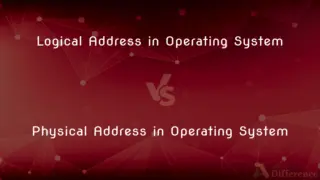ANSI vs. ASCII — What's the Difference?
By Tayyaba Rehman — Published on December 2, 2023
ANSI is a standards organization, while ASCII is a character encoding standard it originally published.

Difference Between ANSI and ASCII
Table of Contents
ADVERTISEMENT
Key Differences
ANSI, the American National Standards Institute, is an organization that oversees and approves various standards in multiple fields in the US. ASCII, the American Standard Code for Information Interchange, is a character encoding standard that was one of the original standards endorsed by ANSI.
While ANSI plays a role in many sectors, from industrial practices to IT protocols, ASCII is specifically a 7-bit character code used to represent text in computers. The role of ANSI is broader, whereas ASCII is a particular standard under its vast umbrella.
Over time, ANSI has expanded the original ASCII standard to include additional characters, giving birth to the "ANSI" character set in many software environments. This extension of ASCII by ANSI incorporates characters outside the original 7-bit range.
ANSI's involvement in character encoding doesn't stop at ASCII. It has also approved other character encoding standards that accommodate a wider range of characters. On the other hand, ASCII remains a foundational encoding system on which many other systems are based.
It's essential to recognize the distinction between ANSI as an overseeing body of standards and ASCII as a specific standard for character encoding. While ANSI has touched many areas with its standards, ASCII remains specific to text representation in computing.
ADVERTISEMENT
Comparison Chart
Nature
Standards organization
Character encoding standard
Scope
Broad, across multiple sectors
Text representation in computers
Character Bits
Extended character sets can go beyond 7 bits
7-bit character code
Extensions
Has endorsed extensions of ASCII
Original standard without extensions
Primary Role
Overseeing and approving standards
Representing characters in computing
Compare with Definitions
ANSI
The American National Standards Institute overseeing US standards.
The ANSI certification assures products meet certain quality benchmarks.
ASCII
American Standard Code for Information Interchange, a 7-bit character encoding.
ASCII values represent characters in computing, like 'A' being 65.
ANSI
An organization that approves a wide range of technical standards.
Many industries look to ANSI for best practices and guidelines.
ASCII
A foundational text representation system in computer technology.
ASCII has been integral to text processing since early computing.
ANSI
An institute that impacts numerous sectors with its approved standards.
From safety protocols to IT, ANSI standards are ubiquitous.
ASCII
An encoding scheme originally endorsed by ANSI.
ASCII was one of the first character encodings to gain widespread adoption.
ANSI
A group that has endorsed and expanded character encoding standards.
Beyond ASCII, ANSI has endorsed various character encoding systems.
ASCII
A system on which many modern encoding standards are based.
Unicode extends the principles established by ASCII to a broader character set.
ANSI
A body that collaborates with other organizations on international standards.
ANSI plays a pivotal role in global standard harmonization.
ASCII
A standard that defines characters ranging from alphabets to control characters.
The ASCII system includes codes for both letters and commands.
ASCII
A standard for assigning numerical values to the set of letters in the Roman alphabet and typographic characters.
ASCII
Persons who, at certain times of the year, have no shadow at noon; - applied to the inhabitants of the torrid zone, who have, twice a year, a vertical sun.
ASCII
The American Standard Code for Information Interchange, a code consisting of a set of 128 7-bit combinations used in digital computers internally, for display purposes, and for exchanging data between computers. It is very widely used, but because of the limited number of characters encoded must be supplemented or replaced by other codes for encoding special symbols or words in languages other than English. Also used attributively; - as, an ASCII file.
ASCII
(computer science) a code for information exchange between computers made by different companies; a string of 7 binary digits represents each character; used in most microcomputers
Common Curiosities
What is the main function of ANSI?
ANSI oversees and approves a variety of standards across multiple sectors in the US.
Is ASCII the only character encoding standard endorsed by ANSI?
No, ANSI has endorsed and expanded upon other encoding standards beyond ASCII.
Why is ASCII foundational in computing?
ASCII provides a consistent way to represent text, serving as a basis for many subsequent encoding systems.
What does ASCII primarily represent?
ASCII is a 7-bit character encoding standard for text representation in computers.
How does ANSI's character set differ from ASCII?
ANSI's character set can incorporate characters outside the original 7-bit range of ASCII.
Who manages ANSI?
ANSI is managed by representatives from various industries, academics, and government agencies.
How has ASCII evolved over the years?
While ASCII remains a 7-bit system, its principles have been expanded in newer encoding schemes like Unicode.
How does ANSI ensure the relevancy of its standards?
ANSI collaborates with industries, government, and academia to ensure standards remain current and relevant.
Why is ASCII limited to 7 bits?
ASCII was designed for early computers with limited memory and processing capabilities.
Can ANSI standards be applied internationally?
Yes, ANSI collaborates with other bodies to harmonize standards on an international level.
Does ANSI deal exclusively with IT standards?
No, while IT is a part, ANSI's scope covers numerous sectors including health, safety, and more.
How do modern encoding systems like Unicode relate to ASCII?
Unicode, while more expansive, extends the foundational principles established by ASCII.
What was the need for ASCII in early computing?
ASCII provided a standardized way to represent and process text in computers.
What sectors does ANSI impact with its standards?
ANSI's standards touch areas like IT, manufacturing, safety protocols, and more.
Are ASCII codes the same across different machines and platforms?
Yes, ASCII ensures a consistent representation of characters across varying platforms.
Share Your Discovery

Previous Comparison
Internet vs. World Wide WebAuthor Spotlight
Written by
Tayyaba RehmanTayyaba Rehman is a distinguished writer, currently serving as a primary contributor to askdifference.com. As a researcher in semantics and etymology, Tayyaba's passion for the complexity of languages and their distinctions has found a perfect home on the platform. Tayyaba delves into the intricacies of language, distinguishing between commonly confused words and phrases, thereby providing clarity for readers worldwide.















































